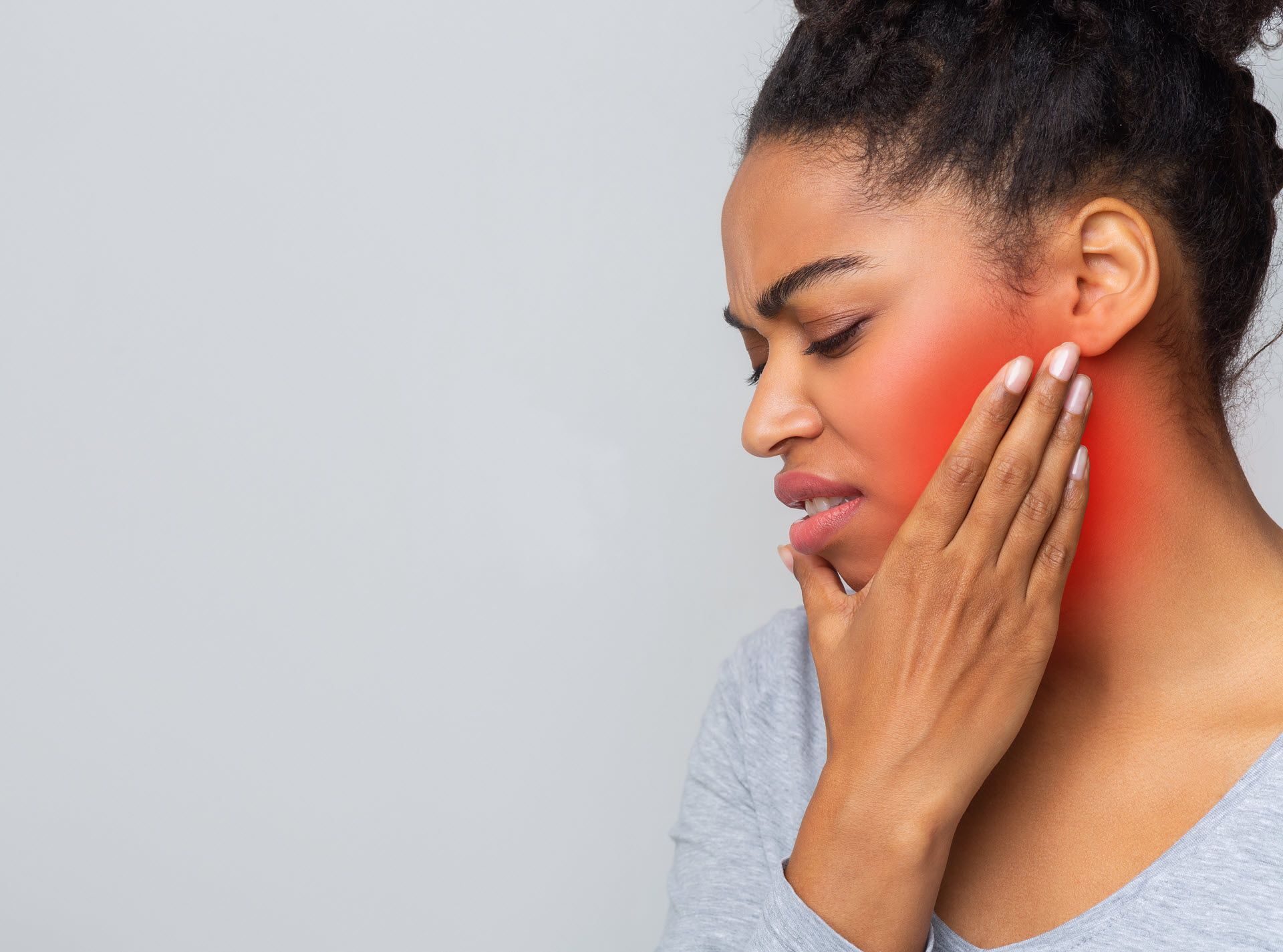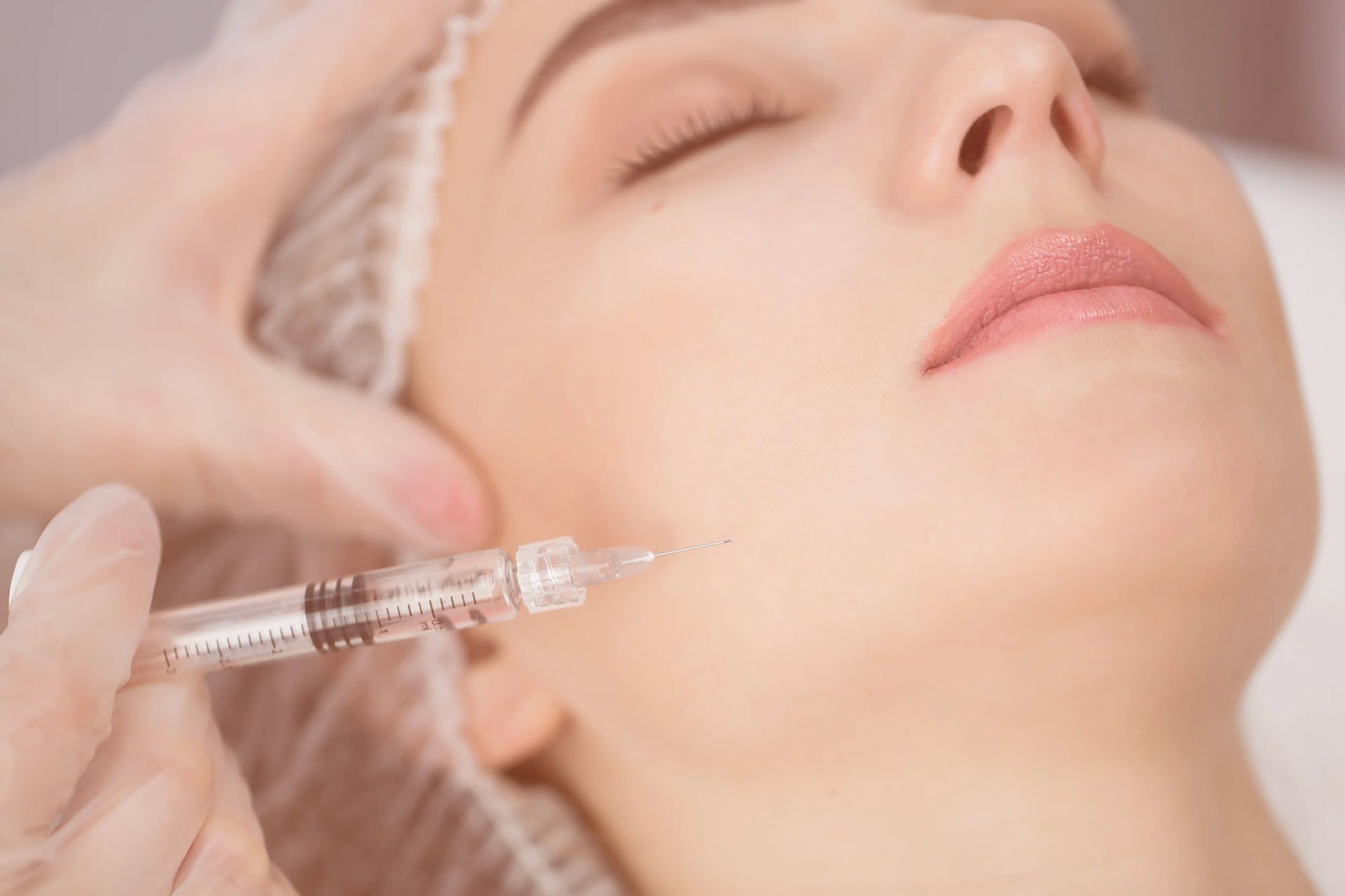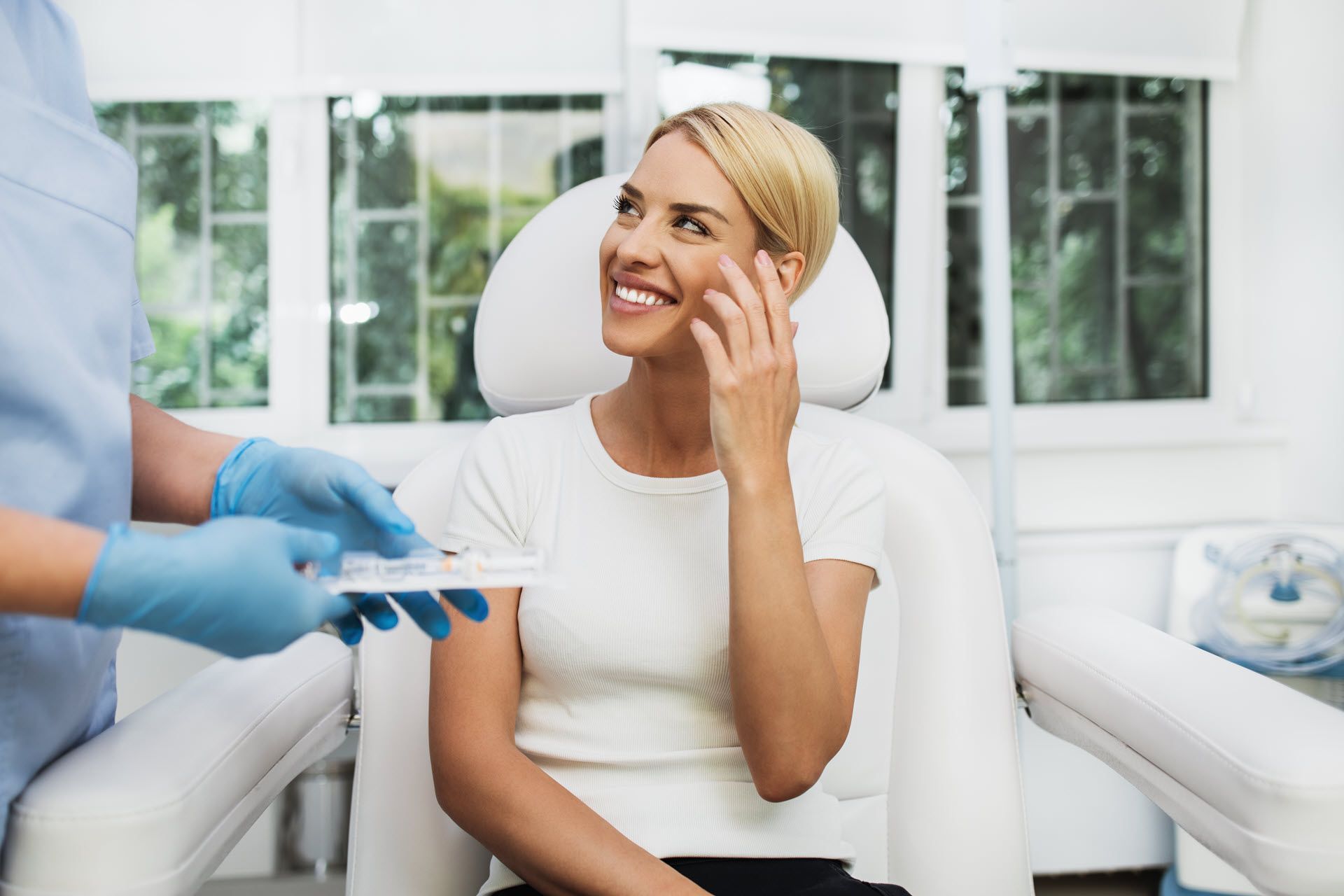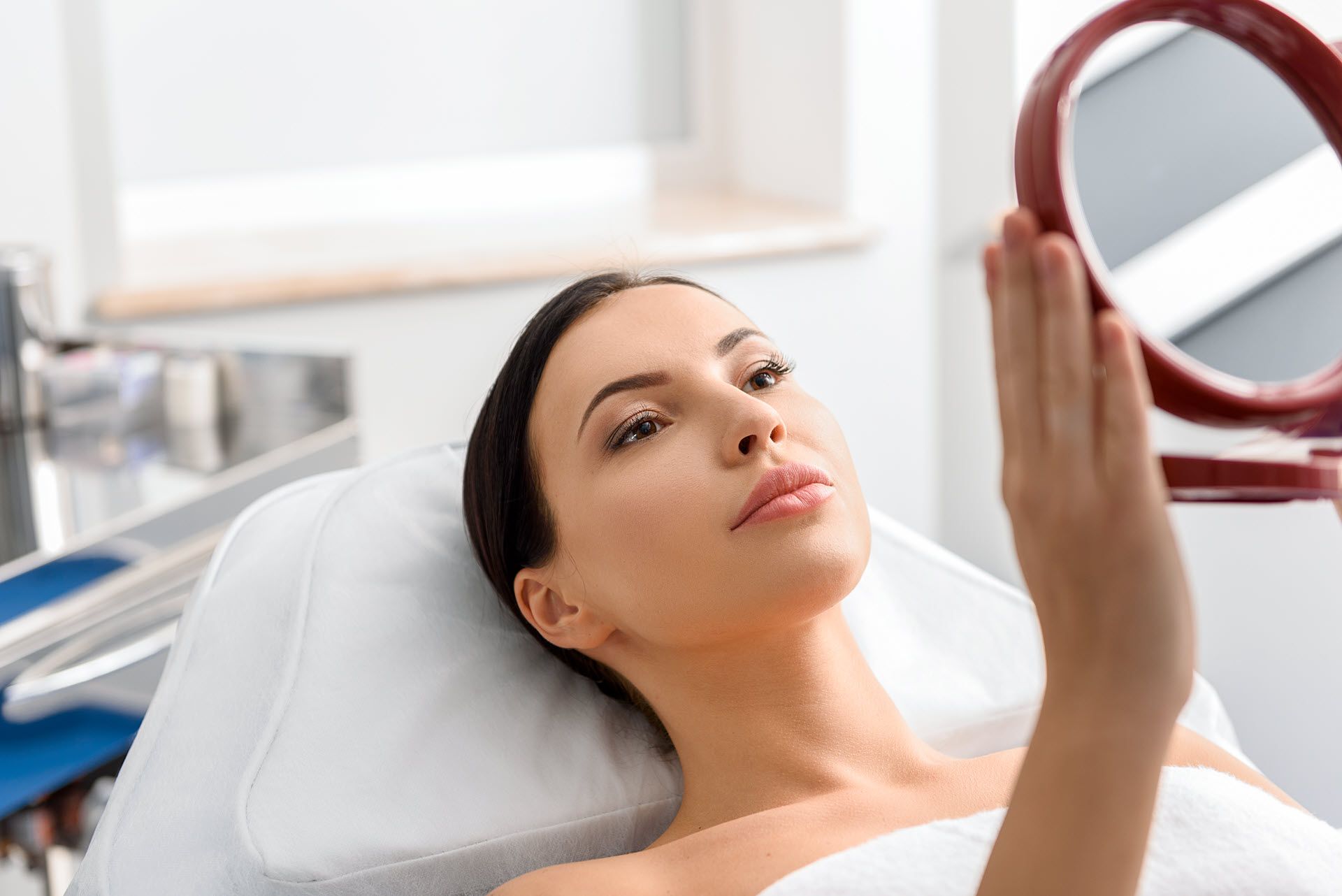Cosmetic Treatments and Botox for TMJ
Say goodbye to jaw pain, clenching, and TMJ
You may be familiar with Botox® being used for cosmetic reasons to achieve a more youthful appearance. However, it is also used therapeutically for facial pain, headaches, and even temporomandibular (TMJ) disorders.
That’s right! Get ready to say goodbye to teeth clenching and headaches with the amazing power of Botox for TMJ disorder! A Botox® treatment in the muscles responsible for clenching can provide relief for 3-6 months for individuals experiencing symptoms such as jaw pain, locking, clicking, clenching, and grinding.
What is TMJ?
TMJ (temporomandibular joint disorder), is caused by the displacement or swelling of the temporomandibular joint due to certain stressors. The temporomandibular joint (TMJ) is located bilaterally at the junction between the skull and jawbone.
To engage in daily activities such as swallowing, speaking, and potentially grinding or clenching your teeth during sleep, you can place two fingers on either side of your face, just in front of your ears, and open your mouth. One can observe the importance of the jaw muscles in common movements of the head and neck.
TMJ Symptoms
- Jaw pain can vary in sensation, ranging from a dull ache to a sharp discomfort.
- The jaw may experience popping or clicking sensations when chewing or talking, which can sometimes cause discomfort.
- There may be a limited ability to open or close the jaw, also known as lockjaw.
- There is swelling in the face.
- Pain in the neck and/or shoulders.
- Common types of pain include headaches and toothaches.
- Symptoms of earaches can include ringing in the ears.
TMJ Causes
The most common causes of dental problems include teeth grinding (bruxism), clenching of teeth, and vigorous chewing of tough or crunchy foods.
Lockjaw, also known as a more severe form of TMJ, occurs when excessive stress on the jaw causes it to lock and restrict movement of the mouth.
Additionally, various forms of stress, not necessarily associated with the use of the jaw muscles, can contribute to the discomfort experienced with TMJ. During times of stress, whether it be from work, school, or a busy lifestyle, it is common to experience tension in the muscles around the face and neck. This can often result in clenching of the teeth. These factors should be acknowledged and dealt with as they all contribute to the symptoms of TMD.
Botox Therapy for TMJ
Botox can be considered as a treatment option for individuals experiencing TMJ pain (temporomandibular joint disorder). Enlargement of the jaw muscles, specifically the masseter muscles (masseteric hypertrophy).
The clenching and grinding of the jaw muscles can lead to enlargement. This may cause cosmetic concerns for women, as it can contribute to a more masculine appearance in the lower face. Mastication habits and gum chewing can exacerbate the issue, so it is advisable to avoid chewing gum if you experience these problems.
Botox is commonly known for reducing wrinkles, but it can also be used for other medical purposes. One such use is for treating TMJ pain, which can have both therapeutic and cosmetic benefits. If you're interested, you can schedule a consultation with Dr. Arash Ghassabei at Artin Dental in downtown Toronto to determine if this treatment is suitable for you.
Areas Treated with Botox For TMJ Therapy
Botox injections can be given in several facial muscles: jaw, forehead and temples. Your dentist will carefully examine your jaw, face, cheeks, and neck and talk to you about your symptoms. Then, they will determine where and how many injections are needed at each visit.
Dentists possess the required expertise in facial anatomy, structure, nerves, and muscles to administer Botox®. However, the utilization of Botox® is currently limited to a small proportion of dentists. Botox® is derived from the botulinum toxin and has the ability to temporarily immobilize muscles. The injections may cause a sensation similar to a bee sting.
Getting Botox or Juvederm Treatments is as easy as 1-2-3
- Book your first appointment and consultation at Artin Dental clinic.
- Discover your perfect smile with a personalized consultation and treatment plan from our talented cosmetic dentist.
- Experience the transformative power of cosmetic Botox or Juvederm (dermal filler) and unveil a rejuvenated and revitalized version of yourself! During your next dental exam and cleaning appointment, you have the option to include cosmetic Botox or Juvederm.
Cosmetic Treatments and Botox Therapy in Downtown Toronto
At Artin Dental in downtown Toronto, we offer dental Botox for jaw clenching, tooth grinding, and TMJ pain relief, as well as cosmetic Botox for our patients.
Appearance can greatly impact our emotions. Signs of aging like stained teeth, wrinkles, fine lines, and crow's feet can make us appear older than our actual age. To address this, our dental office in Havre de Grace goes the extra mile by offering cosmetic Botox and Juvederm to our patients. All the necessary resources for your personal care and well-being are available in our dental office.
Botox and Juvederm are injections that typically last for 3-6 months. Botox is used to reduce wrinkles and fine lines by immobilizing muscles, while Juvederm is a dermal filler that adds volume to the skin using hyaluronic acid. Both treatments are non-permanent and have been scientifically proven in the field of cosmetic treatments.
Dental Botox is an effective treatment option for TMJ disorder, migraine headaches, jaw clenching, and chronic bruxism. It involves a quick injection every 3-6 months to block the nerves that signal jaw pain to the brain. This can greatly improve your quality of life without the need for more invasive treatments.
If you are experiencing any of these conditions, consider asking about dental Botox at the Artin Dental office in downtown Toronto.
Book Your Appointment
Book an appointment today with our doctors to discuss Dental Crowns
Frequently Asked Questions
-
What is Bruxism?
The act of grinding and clenching one's teeth is referred to as Bruxism. Sleep-related Bruxism is a condition characterized by grinding and clenching of the teeth during sleep, often occurring without the individual's awareness.
This can result in various problems such as jaw discomfort, tooth erosion, and Temporomandibular Joint Dysfunction (TMJ).
-
Can Botox Treat TMJ?
Yes, the use of botox can provide temporary relief for TMJ. However, it is important to note that botox injections are considered an alternative treatment for TMD and do not address the underlying cause of TMJ.
If injections are effective in providing relief from TMJ pain and discomfort, you can then explore other treatment options, such as adjusting your bite or using a DNA appliance.
-
How Does Botox Help with TMJ and Jaw Tension?
Botulinum toxin injections into the temporalis and masseter muscles can reduce muscle function and provide relief from TMJ-related pain.
Once you have successfully managed facial pain, headaches, swelling, and discomfort, you can focus on addressing external stressors contributing to TMD symptoms.
These symptoms have an impact beyond just your teeth and jaw, which is why a holistic and biological approach is recommended. We can enhance your overall health and wellness by assessing and diagnosing TMJ disorders.
-
How Long Does Botox Last For TMJ?
A typical lifespan of Botulinum toxin A injections targeting TMJ is around 3-4 months.
Upon completion of your treatment, you can expect to resume your regular activities without delay. The instructions provided to you might comprise of:
Do not engage in any rubbing or kneading of the locations where the injections were administered.
For a few hours, maintain an upright sitting position to prevent the botox from migrating into neighboring regions surrounding the injection site.
When experiencing stinging sensations or unease near the injection site, alleviate it by applying a cold pack.
-
Is Botox Treatment For TMJ Safe?
As previously stated, the use of Botox for TMJ is considered an alternative treatment and does not have FDA approval for treating or curing TMD. In other parts of the world, this TMJ treatment is widely utilized and regarded as highly effective.
-
Does Botox Cause Pain After Treatment?
The prevailing aftermaths frequently recorded subsequent to TMJ botox treatment comprise of:
Experiencing a throbbing sensation in the head
Suffering from an infection affecting the respiratory system
Exhibiting symptoms resembling those of the flu
Feeling a sensation of queasiness in the stomach
Encountering a temporary drooping of the eyelid
Possible rare complications that may arise following the administration of Botox for TMJ treatment incorporate:
Injection sites may exhibit a slight reddening or mild swelling.
Sensations of discomfort may arise around the injection sites, reminiscent of the tenderness experienced post-vaccination.
A degree of muscle weakness may be observed.
Inconsequential bruising might be evident around the injection site(s).
-
What are the Risks and Benefits Of Botox?
Like any medical intervention, even a seemingly insignificant one conducted at a dental clinic, there are inevitable hazards associated with the procedure.
Heightened tension in the jaw can arise due to a tightening of the muscles encompassing the jawbone.
In spite of the aforementioned transitory undesirable outcomes, Botulinum toxin A injections for treating TMD demonstrate considerable safety and efficacy.
There is a general consensus among a significant number of individuals that the advantages of something surpass any potential drawbacks.
This treatment option holds great appeal due to the potential alleviation of headaches, including migraines for certain individuals, as well as the prospect of enjoying pain-free chewing.
-
Does Insurance Cover Botox Treatment For TMJ?
Seeking information about coverage for Botox treatment for TMJ is a prudent step that should not be overlooked - it is highly recommended to take the initiative and contact your insurance company directly for this matter.
Majority of insurance policies exclude coverage for this treatment due to its lack of approval from the Food and Drug Administration, categorizing it as an off-label remedy.
The cost of the treatments varies according to the quantity of injections administered and the geographical location of your residence. Generally, you can anticipate spending somewhere between $500 and $1,500, plus occasionally exceeding this amount, as an out-of-pocket expense.
When it comes to any medical treatment or procedure, it is crucial that you engage in an open and honest conversation regarding the expenses with the staff at your dentist's office.
-
What are the Alternative Treatments for TMJ?
Upon careful assessment, your dentist might propose alternative treatment choices, which could include:
Identifying and tackling the underlying cause of sleep apnea and potentially relieving discomfort resulting from teeth grinding during sleep (I do not recommend the use of mouthguards/night guards, as they do not address the root cause of the condition)
Implementation of dry needling
Administration of muscle relaxants
Utilization of over-the-counter medications such as analgesics and anti-inflammatory drugs
Engagement in physical therapy
Application of open-joint surgery to mend or replace the affected joint
Performance of minimally invasive arthroscopy
Application of minimally invasive arthrocentesis, which aids in removing debris and inflammatory byproducts from the jaw
Undergoing surgery on the mandible joint
Utilization of acupuncture
Exploring alternative relaxation techniques
-
What is the Safest Treatment for TMJ?
Botox has been found to provide temporary relief for TMJ symptoms, according to a few studies, although the majority of experts concur that extensive investigation is required to establish its effectiveness.
On the other hand, I must emphasize that there are inherent hazards associated with it, apart from the potential discomfort you may experience at the injection site. Your decision to assume these risks may vary based on your individual encounters.
Aching head
Respiratory ailment
Symptoms resembling flu
Queasiness
Brief sagging of the eyelid
When it comes to contemplating any type of treatment, I urge you to be inquisitive and delve into comprehending the myriad of treatment choices that exist.
-
What is Temporomandibular Joint Dysfunction (or TMJ)?
The joint connecting the lower jaw to the skull is known as the temporomandibular joint. TMJ, which is commonly abbreviated for temporomandibular joint, is a term that refers to a range of disorders affecting the jaw joint.
TMJ typically manifests as pain resulting from tension and grinding, affecting areas such as the jaw, face, neck, or ears, and can range from mild to extremely severe. Headaches and ringing in the ear (tinnitus) are commonly experienced symptoms as well.
-
Why do Bruxism and TMJ Dysfunction Happen?
Muscle pain in the jaw, temporomandibular joint dysfunction, and headaches can be caused by factors such as stress, anxiety, sleep disorders, natural structural irregularities in the jaw, and certain medications such as SSRIs.
-
How does a Botox® Treatment help Jaw Pain and Clenching?
Botox® is injected into the masseter muscles, which are responsible for clenching and grinding, in a quick and relatively painless treatment. In addition to the temples, other areas of the head, such as the forehead, can also be treated if headaches are a concern.
-
How quickly will I have improvement from my pain? How long will my results last?
Patients can typically expect pain relief within 2-4 weeks after treatment, which typically lasts an average of 3-6 months. However, the duration may vary depending on the individual and the dosage administered.
-
What are the Potential Side effects of Botox® for TMJ and Bruxism?
Experience with this treatment typically results in minor side effects. Some mild bruising and discomfort may be experienced for a few days. It is normal for your jaw to feel fatigued while chewing tough foods for a week or two as the Botox® takes effect, but this sensation will completely disappear.
Temporary relaxation of adjacent muscles may occur, such as the muscles responsible for smiling, which can sometimes be affected for a few days to weeks but will eventually fully resolve.
-
Should I wear a Mouth Guard for Tooth Grinding?
Patients often visit their dentists to address the potential harm of teeth clenching and grinding, whether it occurs at night or during the day. A commonly recommended solution for tooth protection is a night guard. However, many patients do not experience a reduction in their tendency to clench and grind, nor do they find relief from resulting symptoms such as jaw pain, clicking, headaches, or tinnitus.
-
What Happens if I Leave TMJ and Bruxism Untreated?
TMJ dysfunction and clenching are no joke! They can wreak havoc on your teeth, causing cracks and erosion in your joints. If left untreated, it can even lead to the dreaded arthritis of the temporomandibular joints. Don't let your jaw become a ticking time bomb! Temporomandibular joint arthritis is a degenerative condition that causes pain, inflammation, and dysfunction in the jaw due to the breakdown of cartilage.
-
Is my Consultation Covered by OHIP?
OHIP covers the initial consultation for Bruxism/TMJ. The medical Botox treatment is eligible for tax deduction and your receipt will include the required information. However, the majority of drug plans do not currently provide coverage for this particular treatment.
Navigation
Services
Business Hours
- Mon, Wed, Thu
- -
- Tuesday
- -
- Friday
- -
- Sat - Sun
- Closed
All Rights Reserved | Artin Dental Office
Website & Marketing by nerDigital.com





